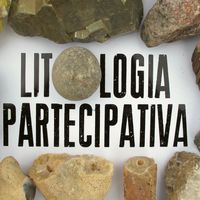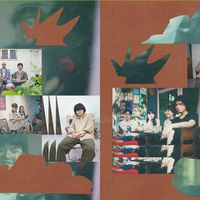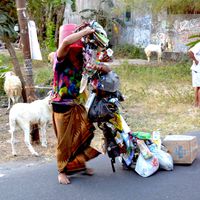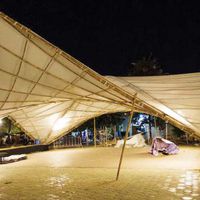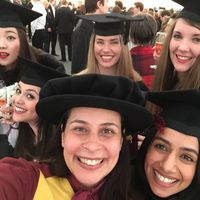#art&technology: The Metalliferous Hills Jug Band from Southern Tuscany

Welcome to culture360.ASEF.org new series of articles on #art&technology! What do rock music and science have in common? According to Andrea Giacomelli and its band Jug Band dalle Colline Metallifere quite a bit. To be precise this connection is called Geomusic and it intends to act as liaison between these two topics. The band projects are developed by producing music that embed environmental engineering topics and scientific outreach, in a way that that will keep audiences entertained while learning things that they can apply at home.
To what extent will music relate to environmental engineering?
.jpg)
Growing up as an environmental engineer and researcher I have always liked the idea of music as a soundtrack to my work. Speaking of a soundtrack, I am not referring to background music which one can have in his earphones while running a simulation, processing satellite imagery, or any other geeky task you may be exposed to in this field, but to songs which can actually relate to issues you are dealing with.
In 2007 I started to be progressively engaged in a series of projects concerning the protection and promotion of lesser known assets in the fields of culture, environment, and open innovation. A lot of the issues in this work are related to rural areas, starting from the Metalliferous Hills of Southern Tuscany (some 80 kilometers southwest of Florence) as a primary site for a combination of personal and professional reasons. Also, one of my core lines of work is to consolidate relations between situations which are not always directly linked, including different media to improve the outreach components of my activities.
The trigger event
Sometime in March 2015 I casually went to hear a band I didn’t know, called Etruschi from Lakota, playing at a local club in my area. Their performance impressed me first of all for their energy and their “vibe”. The second thing I noted was the focus of their lyrics: a lot of the songs from their album was discussing the history of farmers, conditions of rural areas, stories of young folks from Italy who relocate to the city and missed their rural settings. In fact, a lot of the stories they sang sounded very close to many of the topics I was addressing in my job. Plus, their music was very close to my taste, in terms of strong rock-blues roots. The band seemed a natural candidate for an experiment I had been thinking about for some time in the context of citizen science and outreach activities I was conducting, i.e. merging the scientific activities with the musical ones.
From concept to practice and unexpected empowering results

I started to interact regularly with the band members, getting to know better their creative process, and sharing with them the rationale of some of my projects based on participatory mapping, such as the BuioMetria Partecipativa initiative on light pollution monitoring, or the Farma Valley Community Map project, concerning the documentation of place names which are not maintained by official cartography.
We then started to explore our idea in a series of events, primarily with two of the band members (Dario Canal as a lead vocalist and Simone Sandrucci on guitars and banjo). For example, we presented at a national conference on geographic information systems in Genova, in February 2017; I presented while Dario and Simone from the band were playing.
Meanwhile, I had the opportunity of engaging another specialist interested in this interdisciplinary approach. Wolfgang Scheibe, a German expert in biodynamic agriculture, but also with a musical history (he was already playing in the late Sixties in the Stuttgart area and still has a quite peculiar hand-made built one-string bass). Furthermore, Wolfgang is a professional graphic designer and maintains a traditional print shop that provides posters and flyers with a vintage effect. This is an element complementing the “rural” tone we like to use as an envelope for some of the technical work.
As a dual aspect of engaging musicians to support scientific outreach activities, a side effect has been of engaging scientists into musical aspects of the project. This translated into renewing my drumming skills back from my teenage years and becoming part of the rhythm section of the band.
We decided to brand the project as the “Metalliferous Hills Jug Band” (in Italian “Jug Band dalle Colline Metallifere” or JBCM), to summarise in its name our geographic origin and the concept of a band which can perform with a combination of conventional and hand-made instruments, or otherools.
Combining two different channels in a performance
A JBCM performance can be modulated between two “channels”. On one side we have the musical channel, with a track list of some 40 songs, of which about half are original compositions, the others being either covers or just songs we like and which we know will help people to “tune in” the more technical aspects of a performance. On the other side, we have the cultural/scientific channel, where we propose talks, lectures, photo exhibitions, and installations composed by various items, such as maps, sensors, press clippings, ancient game balls, typical Tuscan delicatessen (available for tasting while they last). These components are arranged on and around the stage just before the event, accounting for the mood of the location, thus creating a setting which is always different, while maintaining a line of continuity in our interdisciplinary approach.
Given its “collective by design” approach and its strong liaisons to participatory projects, the JBCM is also open to collaborations with other artists or experts in other disciplines.
Starting from September 2018 the JBCM team has been performing regularly. Our flagship initiative has been a tour with dates in Milano (with a lecture at the Faculty of Engineering), and a series of concerts in Germany. We also had the opportunity of presenting the JBCM concept to other groups of specialists in the field of empowerment and community engagement, obtaining interesting feedback as an innovative approach to outreach. In time we have found its quality to improve and we keep looking for new venues and opportunities to propose our interdisciplinary approach.
Photo credits
1. The Metalliferous Hills Jug Band logo, designed and hand-printed by Wolfgang Scheibe (also bass player and biodynamic agriculture expert with the band).
2. The JBCM in Sachsenheim, Germany, May 2019 (© Rainer Gautschi)
3. The JBCM at the Faculty of Engineering, Politecnico di Milano, Italy, May 2019 (© Vittorio Giacomelli)
More information:
The Metalliferous Hills Jug Band official site: http://www.pibinko.org/jugbandcollinemetallifere/who-are-we/
Andrea Giacomelli (www.pibinko.org) has an MS in environmental engineering and a PhD in hydrology, both from Politecnico di Milano, Italy. Since 1994 he has been involved both in local and international projects, covering aspects of research, consulting, and training working in science and technology parks and corporations. In 2007 he started to create a projects involving a combination of culture, environment, and open innovation and covering a rather diverse range of topics, from ancient games to light pollution, with the common denominator of participatory methods and engagement of multiple modes of communication. He is based in Southern Tuscany.
Similar content
posted on
13 Apr 2020
posted on
31 Aug 2022
deadline
07 Dec 2020
posted on
27 Apr 2017
05 May 2021

